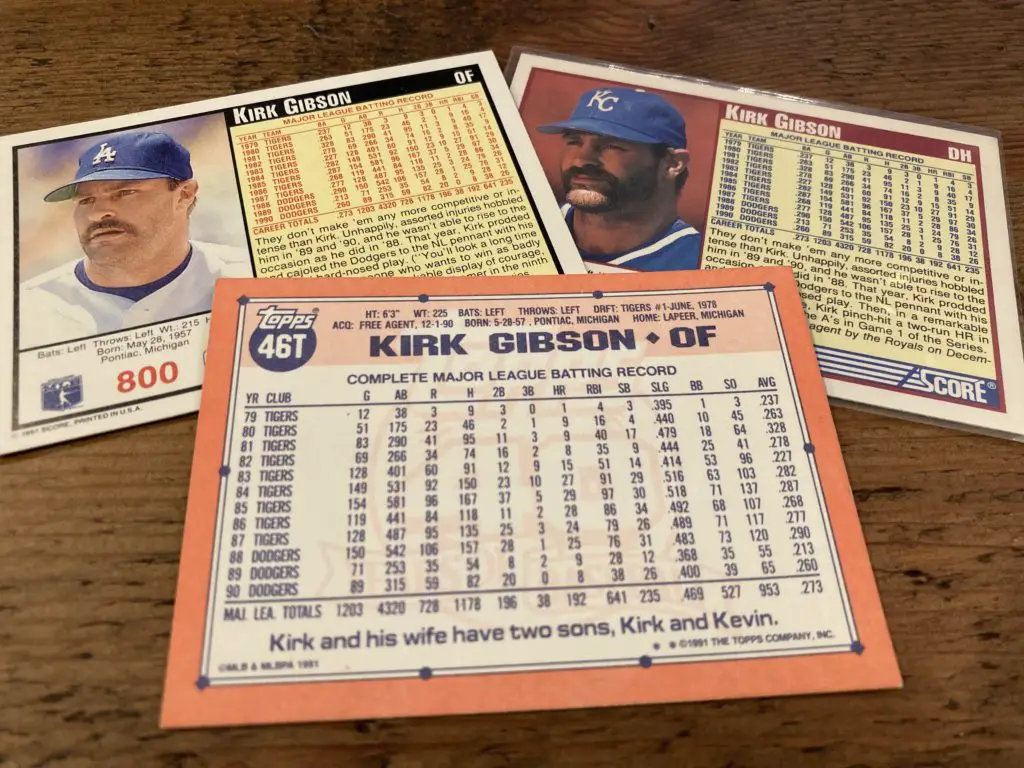For avid fans of a sport, the back of a sports collectible card isn’t going to tell you very much.
You might get a little bit of interesting information, a short biography, and then a lot of details from the manufacturer.

But if you’re a serious card collector, then the back of the card is home to some of the most vital information.
The numbers on the back of sports cards typically indicate where it comes in a print run, and the number of cards created.
So, a 2/10 would be the second card of a limited run of 10. 536/1000, on the other hand, would mean that your card was printed at the midpoint of a larger run.
Sports card collectors can use these numbers to determine the rarity of a specific card.
Numbered cards often have a smaller run, while non-numbered cards will be numerous.
Read this guide to understand what the numbers on sports cards mean.

What Does A Numbered Sports Card Mean?
A numbered sports card is a card with a limited printing run. The smaller number produced means this card is rare, and potentially more valuable.
Non-numbered cards are printed in large amounts and hold less value to a collector.
There are two key numbers on the back of a numbered card, and they’re split into a fraction.
The first, smaller, number indicates which specific card you have.
The second, larger, number, indicates how many were printed in total. A card that said 50/100 would indicate that 100 cards were printed, and you’re holding number 50.
Why Are Only Some Sports Cards Numbered?
The only sports cards that are numbered are those with a limited print run.
Card manufacturers such as Topps, Panini, and Upper Deck make a massive amount of cards every year.
Some of these are hugely common, and you’re likely to get one in a pack.
There’s no point in numbering them because, to put it bluntly, they aren’t special. These non-numbered cards are typically base cards.
But only a small number of certain cards are ever printed. These are the rarities, and hold the most value for collectors. The numbers help collectors to see just how scarce a card is.
You might notice that some cards look similar, but some are numbered while others aren’t.
The numbered versions are often parallel cards, while the non-numbered version is a base card.
A parallel card generally has the same image, but a new color scheme.
Most cards do typically have some numbers on the pack, but this is just the number of the card in the set.
These numbers help collectors find what’s missing and complete their set. All cards of the same design, including parallels, will have the same identifying number.
What Is A 1/1 Sports Card?
A 1/1 card is the rarest sports card of all, because only one of them was ever made. If you have a 1/1 card, it means that only one version of that card was ever printed.
To get your hands on a 1/1 card, you need to have either extremely good luck with a pack of cards, or be willing to pay extra for the pleasure of ownership.
1/1 cards are also sometimes referred to as 1-of-1. Just because it’s the only one printed, doesn’t mean it’s always the most desirable. Sometimes, cards with slightly larger print runs and more desirable images sell for more.
What Is SP And SSP In Sports Cards?
SP stands for Short Print, and SSP stands for Super Short Print. These are baseball cards with a very limited number of printings.
SP and SSP tend to differ from parallel cards because they don’t just use different colors, they use a completely different image. They’ll have the same card number as the base card, and a new picture.
As you might guess, there are more SPs than there are SSPs. That said, there doesn’t seem to be any clear agreement between what counts as an SP or an SSP.
There’s also SSSP, or Ultra Short Print. These have very limited prints.
What Else Makes A Numbered Card Special?
It isn’t just the right number, or the amount printed, that you need to pay attention to. Sometimes, where the card fell in the print run can be important.
For example, a 1/50 and a 50/50 can attract more attention than a number in the middle.
Another thing to take note of is if the left number matches the players’ jersey number.
Sports card collectors like the little bit of symmetry and tend to pay more. Parallel cards that match the team colors can also bring the price up!
What Other Numbers Are On The Back OF A Sports Card?
A standard base card will have several key numbers on the back: the number of the card in the set, the year/season it was printed in, and the card code.
The number of the set is useful for collectors looking to complete a set, as they can easily identify what’s missing.
The year/season helps identify the card and when it was printed, which is useful when collecting vintage cards.
The card number is mostly used by the manufacturer, but can help collectors identify SP and SSP cards.
Numbered cards also have a serial number, which is displayed in a fraction. These are on SP and parallel cards.
The fraction shows how many cards were printed, and where this card came in the print run.
What Does #52, #/100 Mean?
You might see a code like this when searching for cards to buy online. #52, #/100 would mean that there were 100 prints made of card number 52. These codes can help collectors identify rare cards and vintage cards.
Final Thoughts
When you open up a pack of cards, you probably look at the pictures first, and then read the back.
But it’s the numbers on the back of the card that help collectors find the rarest and most valuable cards.
Collecting numbered sports cards is fun, but it’s not easy. You need a lot of patience and persistence to find the ones you want.
- Bo Jackson Rookie Cards for savvy collectors - March 19, 2023
- Bo Bichette Baseball Rookie Cards - March 11, 2023
- Great Value baseball cards from the 60’s under $500 - March 4, 2023

